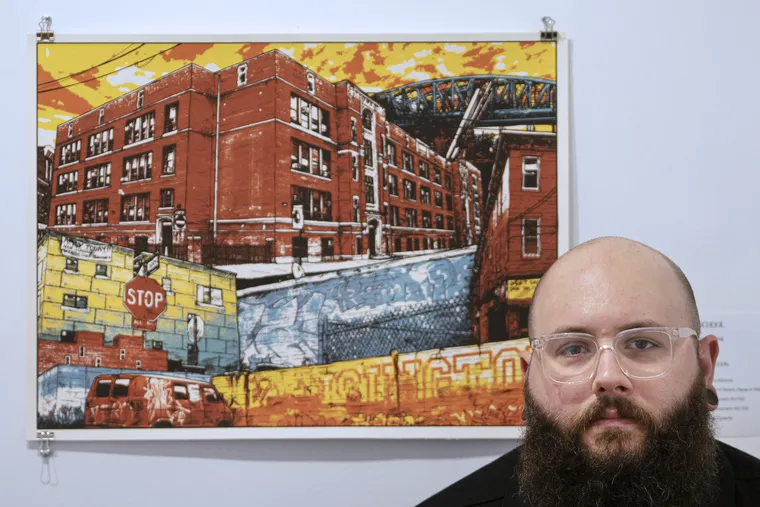For a time, public schools were showpieces of their neighborhoods, representing vast investments in education and a hope for civic engagement and a better world.
A century after the Progressive Era of U.S. education, many of the Philadelphia public schools that were built as showpieces of their neighborhoods still stand. They are beautiful, still, but also underfunded and badly in need of repair, a “testament to the disinvestment in public schools,” said Michael Smaczylo, a teacher and artist whose work examining the educational and social landscapes of the city is now on display in a South Philadelphia art gallery.
Walk inside the Da Vinci Art Alliance in South Philadelphia, and you’ll see Smaczylo’s vision of Philadelphia through 10 silk-screened posters. There’s McClure Elementary, in oranges and yellows, set amid the bodegas of Hunting Park, and Tilden Middle School towering over Southwest Philadelphia, with a SEPTA bus driving past rowhouses and beauty shops. Emlen Elementary has a softer feel, with trees and a vivid sky, the way Smaczylo sees the city as it transitions from Germantown to Mount Airy.
“I wanted the prints to feel like those neighborhoods,” Smaczylo said. “Each one of them has a story to it.”
“Reimaging Monoliths” runs through Oct. 12 at the Bella Vista gallery.
For Smaczylo, a self-described illustrator, printmaker, painter and “retired street punk,” it feels a little surreal. The work began as his graduate thesis for Temple University’s Tyler School of Art, examining six Progressive Era Philadelphia schools in their architectural and neighborhood context. When Smaczylo’s partner suggested he apply for a fellowship at the Da Vinci Art Alliance to broaden and display the work, he balked.
“I said, ‘I don’t know, I’ve never been an artist before,’” Smaczylo said. “As a cis white dude, I didn’t think of myself as having anything to say because of my privilege.”
But Da Vinci loved Smaczylo’s proposal, and awarded him a Kathryn Pannepacker Fellowship that centers on social justice work.
Each poster represents a vast amount of work, and was carefully chosen to represent different sections of the city and grade levels. First, Smaczylo would walk the neighborhood, taking photographs of the buildings and the surrounding area. Then came digital collages, painstaking hand drawing, then multicolor silk-screen prints. Smaczylo also researched school funding structures and the history of control of Philadelphia’s schools, as well as property values and demographics in the neighborhoods surrounding the schools he chose.
There were days he would teach for eight hours, then head to the studio and work past midnight to make the exhibit happen on time.
Smaczylo grew up in Frankford, attending the now-closed Northeast Catholic High School and University of the Arts, focusing on illustration. He bounced around, working various jobs, but kept teaching in the back of his mind.
“All my punk rock friends that had the punkest job I knew were teachers,” said Smaczylo. “You’re doing your best to work the system for kids.”
For three years, Smaczylo has taught art at Kensington Health Sciences Academy, a neighborhood high school that’s earned kudos for its tight-knit feel and the opportunities it affords students. He loves the work, but sees it as doing the best for kids despite what the larger world has handed public schools. (This theme was explored in detail at a panel discussion on school funding held in conjunction with the opening of Smaczylo’s exhibit in September.)
Smaczylo considers KHSA fortunate — it “has air-conditioning. It isn’t falling apart. We don’t have asbestos issues.” That said, the evidence of a lack of funding in public education is everywhere, Smaczylo said.
He copes with large class sizes — his largest class has 37 students these days; last year, it was 41. Across the city, many athletic fields are in poor shape. The city’s art teachers pool resources to have enough paint and other supplies for their eager students. The list goes on and on.
Kara Mshinda, Da Vinci’s fellowship director, said the exhibit opened her eyes to the realities of the school district. She’s the parent of a school-aged child, but she and her partner opted out of public schools for their child.
“We sent her to a Friends school …,” said Mshinda. “We did not want to take that risk.”
Philadelphia built more than 100 schools between 1905 and 1937, mostly with federal dollars, most of which are still in use, despite a lack of adequate upkeep over the years. The grand buildings of that era sent a message, Smaczylo said: “It was saying, ‘Let’s make our city as amazing as we can.’”
That investment stands in stark contrast to today, when the district is constantly triaging needs at its 300-plus buildings.
“If every school had resources, we could return to what schools were in that era,” Smaczylo said. “We all deserve nice buildings.”
Credit: Source link




